Development of Geographic Information System (GIS)
Info: 9168 words (37 pages) Dissertation
Published: 11th Dec 2019
Tagged: GeographyInformation Systems
Abstract
Geographic data framework (GIS), remote detecting and mapping have a part to play in all geographic and spatial parts of the improvement and administration of marine farming, satellite, airborne, ground, and undersea sensors obtain a significant part of the related information particularly information on temperature, ebb and flow speed, wave stature, chlorophyll fixation, land and water employments. Gis is utilized to control and break down spatial and characteristic information from all sources. It is likewise used to create reports in a guide, database and content organization to encourage basic leadership.
The target of this report is to represent the courses in which Geographic Information System, remote detecting and mapping can assume a part in the advancement in connection to contending and clashing employments. Remote detecting assumes a vast part in the upgrade of any GIS, and as a rule, permits information to wind up noticeably a great deal more relatable and helpful for anybody. A GIS gets a large portion of the information for its inherent layers from remote detecting stages, for example, satellites, radars and so forth. Inactive sensors add to symbolism and information for land cover mapping, change recognition, snow observing, warm changes and territory displaying. Dynamic sensors contribute intensely to information for greatly exact territory models known as Digital Elevation Models (DEMs). These Large amounts of information can be georeferenced and coordinated into one expansive GIS, permitting a client to get to an effective measure of data at one time without hardly lifting a finger. The Perspective is worldwide. The approach is to utilize case applications that have been gone for settling a large portion of the imperative issues in reviewing. A short prologue to spatial apparatuses and their utilization in the studying area goes before the case applications. The latest applications have been chosen to be characteristic of the best in class, permitting peruses to make their own particular appraisals of the advantages and cutoff points of utilization of the Geographic Information System in their own train. Different applications have been chosen to show the advancement of the improvement of the devices.
The principle accentuation is on GIS. Remote detecting is seen as a fundamental instrument for the catch of information in this way to be joined into a Geographic Information System and for constant checking of the ecological conditions for operational administration. Maps are one of the yields of a Geographic Information System, yet can be viable instruments for spatial correspondence in their own privilege. Hence, cases of mapping are incorporated. Albeit many Gis have been effectively executed, it has turned out to be very evident that two-dimensional maps with most complex forms and shading mapping can’t definitely show multidimensional and dynamic spatial marvels. Most GIS’s being used today have not been intended to bolster interactive media information thusly have exceptionally restricted ability because of the huge information volumes, extremely rich semantics and altogether different displaying and handling necessities. Each spatial information show has a few option information structures, and each structure can be put away carefully with many document designs.
This report talks about a portion of the elements of the Geographic Information System, the general patterns in the overview field and the innovation behind it.
TABLE OF CONTENTS
ABSTRACT………………………………………………………………………………
LIST OF FIGURES AND TABLES………………………………………………………
ACKNOWLEDGMENTS…………………………………………………………………
- INTRODUCTION……………………………………………………………………
- Purpose ………………………………………………………………………….
- GIS Techniques & Technology…………………………………………………
- GIS Uncertainties……………………………………………………………….
- BACKROUND………………………………………………………………………
- The GIS Dark Ages…………………………………………………………….
- GIS Pioneering…………………………………………………………………
- Canada Geographic Information System (CGIS)……………………………….
- DATA……………………………………………………………………………….
- Data Capture…………………………………………………………………….
- Data Analysis…………………………………………………………………..
- Data Mining……………………………………………………………………
- Geographic Data……………………………………………………………….
- APPLICATIONS………………………………………………………………….
- LIDAR…………………………………………………………………………
- Geocoding…………………………………………………………………….
- SPATIAL ANALYSIS WITH GIS……………………………………………….
- Hydrological Modeling………………………………………………………
- Cartographic Modeling………………………………………………………
- Topological Modeling……………………………………………………….
- Geometric Networks…………………………………………………………
- OCEAN GIS INITIATIVE………………………………………………………
- AREAS OF FOCUS……………………………………………………….
- CONCLUSION…………………………………………………………………
Acknowledgment
Throughout the course of researching and writing this report. The team has had great luck with having many valuable sources. The writers would like express gratitude to the people that made this possible.
The writers wish to thank Ms. Cathy Kwasney, Instructor of ENGL 1282 Effective communications at the Northern Alberta Institute of Technology, for the all the feedback and support on technical report writing, Ms. Kwasney’s feedback has improved the team’s knowledge on the correct way to write a report.
The team would also like to thank GIS Specialist Derek Roopchan from McElhanney for taking the time to answer a few questions for the report thus providing great insight and knowledge from the perspective of somebody with real hands on experience.
- Introduction
GIS stands for Geographic Information System, and it relates to any type of system that captures, stores or presents geographical data. The establishment of Geographic Information System (GIS) has enabled the process of various information into meaningful data used by individuals in endless possibilities. The information in a GIS relates to the characteristics of geographic locations or areas. In other words, a GIS answers questions about where things are or about what is located at a given location. The term “GIS” has different meanings in different contexts. It can relate to the overall system of hardware and software that is used to work with spatial information or designed to handle information about geographic features. It may also relate to an application, for example a comprehensive geographic database of a country or region (Borneman, E. 2014). Geographic Information System is a tool not simply used for “map making” but offers a range of uses, from changing how we navigate the planet to making virtually impossible knowledge about disease and plaque possible. Through this technology, it’s possible to visualize, analyze, and understand patterns and relationships.
- Purpose
The purpose of this report is to provide the reader(s) with a better understanding of how geographic data is created, managed, analyzed and displayed on maps. Through this data, large industries such as oil or forestry create cost saving, efficient and eco-friendly improvements on day to day services used all over the world today. GIS allows geomatics engineers to manage and share data and turn it into easily understood reports and visualizations that can be analyzed and communicated to others. This data can be related to both a project and its broader geographic context. It also enables organizations and governments work together to develop strategies for sustainable development. The team intends to display the profound knowledge gained in the research of this topic to engage present and future land surveyors while also being relevant to the field of surveying. The team has selected GIS as a research topic that is both interesting and relevant to future land surveyors.
- Scope
The scope of this report gives a broad approach to the topic of GIS. To get a grasp of what GIS is, it’s necessary to understand how this tool works. The team is focused on detailing when and how GIS was started with relevant background history, the advancement in new technology for data capturing and analysis. This report is focused on the past and present of GIS. Primary limitations of this report is the information collected can be difficult to comprehend for all readers without any prior knowledge of the topic and also the lack of visualization on GIS. It is not within the scope of this report to examine the future of GIS.
- GIS Techniques & Technology
Geographic information system consists of several techniques and technologies contributing to the ability of manipulating and analyzing data. It’s hard to imagine the world today without google, navigation and satellite imagery but it was not always this convenient. Before all these advancements in technology, the world used to create maps using complex survey methods. GIS technology is advancing at an incredible rate and has greatly changed the perspective of a map.
Figure 1.0 Shows the art of cartography (Cartography, n.d.)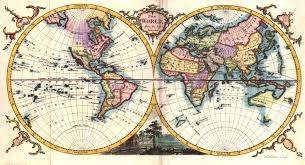
Cartography has changed drastically throughout the years and now mapping the world has gotten more advanced in producing detailed mappings of planet earth which is shown in figure 1.0. This technology allows detailed mapping of the deepest sea floors and highest mountain tops possible today. GIS has taken huge strides with the help of GPS, the relationship between the two is very beneficial for both since GIS takes on ground data which GPS can then use to narrow down locations.
3D displays and the ability to overlay 3D maps on top of one another as shown in figure 1.2 – the next step is 4D, which adds the dimension of time to the equation. GIS already has the ability to adjust to changes in time with multiple map layers that show geographical change in regard to time; it should therefore be theoretically possible to predict what will happen in the future by added predictive modeling features to the system. Future GIS systems will be able to address conflicting land uses (such as a piece of land being designated both as a wildlife preserve and timberland for logging) and propose solutions regarding the most beneficial use of the tracts. (Borneman, E. 2014)
Figure 1.2: (3d contour maps and surface plots software. n.d.)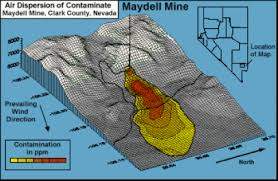
- GIS Uncertainties
In GIS, the term uncertainty is used to describe the incomplete or misrepresentation of data and how uncertainty affects results and decision making. All data and analysis done in GIS has some uncertainty associated with it. These can include unreliability in measurement error or resolution of data and structural uncertainties such as the lack of accuracy as shown in figure 1.3.
Figure 1.3 (Digitizing Vector Data and Digitizing Errors)
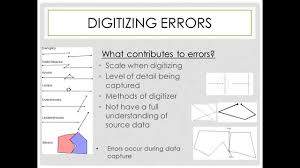
Sometimes those uncertainties matter and sometimes they don’t. That judgement call can only be made effectively when the” purpose of the analysis is clearly articulated and the significance of uncertainty can be appropriately contextualized” (Bolstad, P. 2005). GIS specialists started to accept that error, inaccuracy, and imprecision can affect the quality of many types of GIS projects, in the sense that errors that are not accounted for can turn the analysis in a GIS project to a useless exercise. Understanding error inherent in GIS data is critical to “ensuring that any spatial analysis performed using those datasets meets a minimum threshold for accuracy” (Bolstad, P. 2005). Therefore, managing uncertainty is necessary in order assess whether or not to reduce or absorb uncertainties.
- BACKROUND
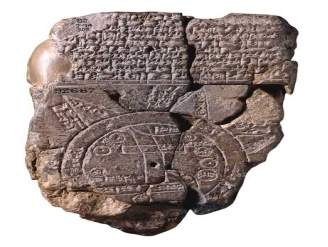
Figure 2.0 (Babylonian World Map. n.d)
The creation of maps which for now are far more advanced than they have ever existed. However, the early stages of this process can be traced back as far as 500 B.C. when, artifacts such as clay tablets from Assyria were made with maps of certain northern Mesopotamian regions (Ondusi, M. 2010). Subsequent discoveries, such as the spherical shape of the Earth, also affected the mapping process positively Shown in figure 2.0. While cartography continued to develop through conducting of tests during the ensuing centuries, newer technologies also came to be developed all together, significant among them being the invention of the computer and its astounding capabilities. It was when the two were brought together that the groundwork for modern day GIS was laid.
- The GIS Dark Ages
The history of GIS goes all the way back to 1854 when London, England was hit by a wave of cholera outbreaks across the city but luckily British physician John Snow was there to solve the problem. He mapped all the cholera affected areas along with roads, properties and water lines after getting all this data he put it together and noticed that the cholera outbreaks were directly related to water lines concluding that the water was contaminated (Hartley, A. 2017). His discovery was special because it gave life to GIS and showed that it could solve problems just by analyzing data, creating maps and layering them which resulted in many lives being saved. The dark ages of GIS before 1960 were simpler times, maps consisted of roads, new developments and points of interest. All this had to be done without computers so the alternative was sieve mapping which used very thin transparent layers of the map viewed under lights to see the areas overlap this was as good as it got but it was very hard to calculate much because the info was so coarse and inaccurate at times, the shift from paper to computerization began since the cartographers and spatial user’s strived to find a more accurate and efficient way to go about it. (Hartley, A. 2017)
- GIS Pioneering
Since the birth of GIS in the late 1960s many changes have taken place, the decision making process has become a lot more mathematical. Before maps were computerized most spatial analysis were limited by manual procedures but computerization changed everything (Berry, J. K. 2007). It enhanced efficiency, increased the volume of data and it made processing a lot faster. This new perspective marked a turning point in how maps were used from combining map layers to spatially characterizing. The 1970s worked with computer mapping automate map drafting. points and lines defined geographic features on maps and were represented as X, Y coordinates (Berry, J. K. 2007). Plotters could draw and connect with a variety of colors, scales and projections with the image (Berry, J. K. 2007). During this time, the pioneers established many concepts and procedures of GIS technology. Computer mapping was so crucial since it had the ability to change portions of the map and redraft entire sections for example updating maps after a tsunami has hit would take months but with the new technology it would take hours. During the 1980s spatial database management systems were developed that connected computers with management databases (Berry, J. K. 2007). In these new systems ID numbers are given to geographic features. For example, the user can go to any part of a map and get data about the location, searches could also be refined for certain conditions. GIS has evolved over the decades from the dark ages of overlaying maps on light tables. The value these advancements in technology made forever got rid of the hard-repetitive tasks users would have to deal with.
- Canada Geographic Information System (CGIS)
Roger Tomlinson, known as the “father of GIS”, was working with the Canadian government 1960s at the time he was the most important piece in creating the Canadian Geographic System. The CGIS took a different approach by adopting a layer system for maps, Canada occupies so much land which prompted the Canadian government to create a Canadian land inventory that was developed in 1964 but wasn’t fully operational until 1971. (Hartley, A. 2017). This land inventory system uses data acquired from soil and climate conditions to determine land capability for crops and green areas. The purpose of the system was to analyze geographic data over any part of the continent. “It quickly recognized that accurate and relevant data was vital to land planning and decision making. Over the years CGIS had been modified and improved to keep pace with technology.” (Hartley, A. 2017)
- DATA Capture
GIS data capture is a technique in which the information of various map attributes, facilities, assets, and organizational data are digitized and organized on a target GIS system in appropriate layers.
Primary data capture techniques use surveying technology to capture the data either remotely or directly by raster data capture or vector data capture. Raster data capture uses information from other data without any real contact, this can be done by satellite imaging and even aerial photography (Schmandt, M. 2014). It’s very beneficial because the data is always consistent and it can be done repeatedly while still maintaining cost efficiency. Vector GIS data capture is being in the control area physically, while using survey techniques such as Differential Global Positioning Systems(DGPS) and total stations (Schmandt, M. 2014). Though this technique is effective at providing real data, however, it is a lot more time consuming and expensive than vector data methods.
The secondary GIS data capture technique use technologies such as scanning, manual digitizing, photogrammetry and COGO by the following methods:
- Scanning raster data hard copies can be georeferenced to get vector output
- Manual digitizing creates an identical vector map on a device which defines the vertices, points and lines etc. (Schmandt, M. 2014)
- Heads up digitizing is when the raster data is scanned and imported and laid beneath vector data to be traced
- Raster to vector conversion uses a software with intelligent algorithms to recognize points, lines and polygon features which gets generated into vector GIS date
- Photogrammetry involves plotters that capture vector data from images this method is effective but can also be costly
GIS Data capture can be used for the following
- Map Creation: transportation facilitation, hydrographic mapping, vegetation and other types of related features;
- Capturing Navigation data for easy navigation
- Survey data for property, land, and water
- Utility infrastructure, water lines, road networks, pavements, sewer networks
- GIS Data capture is done from geological maps, weather maps, mining and mineral exploration maps
- Data Analysis
Data analysis provides a better understanding of the earth by mapping where things are and how those things relate to one another. It’s a big part of GIS because it includes all the variables and characteristics which can be applied to data to prove theories through finding patterns and recording statistics which are not immediately visible.
The techniques of how data analysis works can be broken down into the following steps:
- Step 1: There must be a question or reason for the information required
- Step 2. Begin exploring data while previewing features and attributes to determine if the data will be useful or not. Preparing the data means getting it in the right format which isn’t mandatory but it makes things a lot more organized.
- Step 3: Once it’s collected you must choose which methods of analysis are going to be used and again this comes back to the questions being asked. For example, if information is needed on facilities supplying healthcare start by examining the distribution of hospitals in the area. Another example would be needing to allocate population distribution within a certain area the way to go about this would be identifying zip codes layer based on population density. (Bedker, S. 2009)
- Step 4: Now the last step is to examine and sort the results. In this case shows that the heavily populated areas of 2000 people per square mile have at least 1 health care facility in the area thus allowing a better look at the distribution of the facilities and if they are consistent with the population. (Bedker, S. 2009)
- Data Mining
Date mining is the process of analyzing data from different perspectives and summarizing it into useful information – information that can be used to increase revenue, cuts costs, or both. Data mining software is one of several analytical tools for analyzing data. It allows users to analyze data from many different dimensions or angles, categorize it, and summarize the relationships identified. Technically, data mining is the process of finding correlations or patterns among dozens of fields in large relational databases (Morais, M. 2011). For example, one grocery chain used the data mining software to analyze local buying patterns. What was found was that when men bought diapers on Thursdays and Saturdays, they also tended to buy beer. Further research showed that these men did weekly grocery shopping on Saturdays. On Thursdays, however, they only bought a few things. The retailer concluded that men bought the beer to have it available for the upcoming weekend. The grocery chain could use this newly discovered information in various ways to increase revenue (Morais, M. 2011). For example, moving the beer display closer to the diaper display and increasing the cost of those items on those specific days. GIS combines information through data mining and enables statistical inferences on consumer behavior, population trends and insight for decision makers.
- Geographic Data
“Geographic data come in many types, from many different sources and captured using many techniques; they are collected, sold, and distributed by a wide array of public and private entities” (Berry, J. K. 2007). The data can be separated into two types the first being directly collected data and the other being remotely sensed data. Directly collected data is at the heart of the control area. For example, taking elevations for property lines or doing a stake out survey for a sewer line this is directly collected data, in the field something as small as recording weather temperature is collected geographic data (Gliklich, R. E. 2014). Remotely sensed data is different because it’s possible to collect the geographic data without physically having to be there. An example is using satellites to get satellite imagery of earth, another example would be using sonar to map the ocean’s floor. The directly collected data is important since it is true data that is used to support the data of the remotely sensed data.
4.0 Applications
These days, GIS advancements have been connected to different fields to help specialists and experts in breaking down different sorts of geospatial information and managing complex circumstances (Alam, 2012). Regardless of in business, instruction, neural assets, tourism, or transportations, GIS assumes a basic part to help individuals gather, dissect the related spatial information and show information in various configurations. The significance of Geographic Information Systems (GIS) can scarcely be overemphasized in today’s scholarly and expert field. More experts and scholastics have been utilizing GIS than any time in recent memory – urban and local organizers, structural designers, geographers, spatial financial specialists, sociologists, ecological researchers, criminal equity experts, political researchers, and alike. Thusly, it is critical to comprehend the speculations and utilizations of GIS in our instructing, proficient work, and research. “The Application of Geographic Information Systems” presents explore discoveries that clarify GIS’s applications in various subfields of sociologies (Alam, 2012).
4.1 Light Detection and Ranging (LIDAR)
This is a remote detecting technique that utilizations light as a beat laser to gauge ranges (variable separations) to the earth. These light heartbeats joined with other information recorded by the airborne framework produce exact, three-dimensional data about the state of the earth and its surface qualities. There are two sorts of sensors LIDAR utilizes: dynamic sensors and Passive sensors. Dynamic sensors have its own particular wellspring of light beams and its sensor measures reflected vitality which makes it productive and useable whenever of the day regardless of the possibility that there is overcast cover overcast cover, while then again inactive sensors measure reflected daylight that was radiated from the sun which makes it the most widely recognized kind of earth perception procedure.
A LIDAR instrument comprise of a laser, a scanner, and a specific GPS collector as appeared in figure 4.0. Automatons, planes and helicopters are most regularly utilized stages for securing LIDAR information over wide ranges. Two sorts of LIDAR are topographic and bathymetric. Topographic LIDAR ordinarily utilizes a close infrared laser to outline arrive, while bathymetric LIDAR utilizes water-entering green light to likewise quantify ocean bottom and riverbed heights. LIDAR frameworks permit researchers and mapping experts to look at both regular and synthetic ecological with exactness, accuracy, and adaptability. NOAA researcher are utilizing LIDAR to deliver more exact shoreline maps and make computerized height show for use in geographic data framework, to aid crisis reaction operations and in numerous different applications.
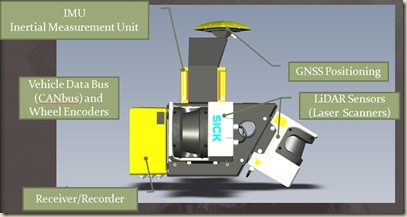
Figure 4.0: LIDAR Scanner
(Ken, 2009)
LIDAR information is gathered when an airborne laser is pointed at the range being overviewed on the ground, the light emission is reflected by the surface it. A sensor records this reflected light to quantify a range. A LIDAR unit filters the ground from side to side as the plane covers a vast range. A few heartbeats will be straightforwardly at nadir yet most heartbeats go at a point (off-nadir). So a LIDAR framework represents edges when it computes height. Light discovery and going is an energizing innovation item which is exceptionally productive. Envision you’re climbing in a woodland, you gaze upward and you see light, this implies LIDAR heartbeats can experience as well. A lot of the LIDAR vitality can infiltrate the woodland covering simply like daylight. LIDAR won’t really just hit the uncovered ground in a forested region, it can reflect off various parts of the backwoods until the beat at last hits the ground (frank, 17). Utilizing a LIDAR to get uncovered ground focuses with one-point shot isn’t conceivable, you’re not shooting through the vegetation. The gadget is peering through the crevices in the leaves as appeared in the figure 4.1. Lidar gathers a monstrous number of focuses. At the point when laser extents are consolidated with position and introduction information created from incorporated GPS and inertial estimation unit frameworks, filter edges, and adjustment information, detail-rich gathering of height focuses called a “point cloud”. Each Point in the point cloud has three-dimensional spatial directions (scope, longitude and tallness) that compares to a point on the world’s surface from which a laser heartbeat was reflected. The direct mists are toward creating other geospatial items, for example, computerized models, shade models, building models, and shapes.
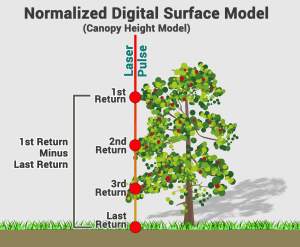
Figure 4.1 Canopy Height Model
(frank, 17)
4.2 Geocoding
Geocoding is a subset of GIS, this is the way toward changing a portrayal of an area, for example, a couple of directions, an address, or a name of a place to an area on the world’s surface (California Environment Health Tracking PRogram, 2010). You can geocode by entering one area depiction at once or by giving a large portion of them without a moment’s delay in a table. The subsequent areas are given as geographic elements, which is utilized for mapping a spatial investigation. You can discover different sorts of areas through geocoding. The sorts of areas you can look for incorporates purposes of intrigue, for example, mountains, scaffolds, and stores; organize in view of scope and longitude or other reference frameworks, for example, the Military Grid Reference System (MGRS) or the US National Grid System; and locations, which can originate from assortment of styles and organizations including road crossing points, house numbers with road names, and postal codes.
Geocoding is utilized for basic information investigation from business and client administration to conveyance systems. To geocode information, you should have a GIS reference layer accessible to go about as your reference layer same as looking over a sewer line with a reference point. The decision of reference information is imperative and will influence the exactness and fulfillment of your outcomes. Road centerlines are all the more regularly utilized as a kind of perspective layer. All around designed centerline GIS information layers have isolate fields for road names. Geocoding is required for some reasons. Georeferenced information is valuable for representation, for example, mapping areas. Geocoding is additionally regularly the initial phase in interfacing ecological and wellbeing information for an alternate assortment of general wellbeing purposes, for example, research and reconnaissance. Georeferenced individual wellbeing result information and socioeconomics offers a capacity to add singular level data to the area level information and natural perils (e.g., spread of ailment or pesticide utilize). Exactness is essential, see that culmination of geocoding as talked about above, doesn’t generally mean accuracy. For instance, you may have two locations without postal divisions: 105th Street, Gateway and 105th, Gateway arrive. In view of its calculations, a geocoding device may choose that both are one and the same and give both of you geocodes in Gateway and none in Gateway arrive. Both coordinated, however one of them is not precise (California Environment Health Tracking PRogram, 2010).
Positional precision is the means by which close a geocoded indicate is the genuine area of that address on earth’s surface. There are other exactness contemplations, for example, presumptions utilized by geocoding calculations and likelihood that the geocoded point is the one that you needed. Geocoding blunders might be more noteworthy in country ranges in view of expansive separations amongst homes and on the grounds that homes might be set a long way from the street, which is especially troublesome for locations geocoded to road centerline reference databases. Addresses coordinated to a centroid reference databases have a tendency to be more exact, particularly in urban zones. Be that as it may, contingent upon the destinations of a geocoding venture, particularly on the off chance that it is craved to put a point on top of a private structure, a rustic geocode on property centroids can give wrong positional precision on the grounds that a vast property may just have a little private structure toward one side of the property.
5.0 Spatial analysis with GIS
Spatial examination is urgent in GIS since it incorporates the greater part of the changes, controls, and techniques that can be utilized to plot information and increase the value of them, to bolster choices, and to uncover designs that are not quickly self-evident. Spatial investigation is the procedure by which we transform vague information into characterized information, the term scientific cartography is now and then used to allude to strategies for examination that can be patriated on maps to make them more valuable and educational (Library, 2010). Spatial demonstrating is an inexactly characterized term that covers an alternate kind of more propelled systems. This incorporates the utilization of GIS to survey and reenact dynamic procedures, notwithstanding dissecting static examples. The human eye and cerebrum are additionally extremely wonderful processors of geographic information and fantastic identifiers of examples in maps and pictures. The approach taken here is to view spatial investigation as spread out along a continuum of refinement, extending from the most straightforward sorts that happen rapidly and instinctively when the eye and mind take a gander at a guide, to the sorts that require complex programming and advanced numerical comprehension (Alam, 2012). Spatial examination is an arrangement of techniques whose outcomes change at whatever point the fact of the matter being overviewed changes after some time.
5.1 Hydrological Modelling
Geographic Information Systems (GIS) has turned out to be especially helpful and vital strategies in hydrology for the logical review and administration of water asset. Since water is dependably in movement, its event differs spatially and transiently all through the hydrologic cycle. In this manner, the investigation of water utilizing GIS is reasonable. A spatial zone and the event of water all through its space changes through time. Hydrologists utilize a hydrologic spending when they concentrate a watershed. “In the hydrologic spending plan, inputs originate from precipitation, surface streams, and groundwater streams” (Droopchan, 2017). Yields leave as evapotranspiration, penetration, surface overflow, and surface/groundwater streams. A large portion of these amounts, including capacity, can be measured or assessed and their attributes can be depicted in GIS and considered. As a subset of hydrology, hydrogeology is worried with the event, appropriation, and development of groundwater. In addition, hydrogeology is worried with the way in which groundwater is put away and its accessibility for utilize (Alam, 2012). The qualities of groundwater can promptly be contribution to GIS for further review and administration of the water assets.
Hydrologic models are streamlined, applied portrayals of a piece of the hydrologic, or water, cycle. They are fundamentally utilized for hydrologic expectation and for understanding hydrologic forms. Two noteworthy sorts of hydrologic models can be recognized:
- Stochastic Models. These models are black box systems, based on data and using mathematical and statistical concepts to link a certain input (for instance rainfall) to the model output (for instance runoff). Commonly used techniques are regression, transfer functions, neural networks and system identification. These models are known as stochastic hydrology models.
- Process-Based Models. These models attempt to speak to the physical procedures saw in this present reality. Ordinarily, such models contain portrayals of surface overflow, subsurface stream, evapotranspiration, and channel stream, however they can be significantly more convoluted. These models are known as deterministic hydrology models. Deterministic hydrology models can be subdivided into single-occasion models and ceaseless recreation models.
Late research in hydrologic demonstrating has adopted a more worldwide strategy to the comprehension of the conduct of hydrologic frameworks trying to improve expectations and to address the real difficulties in water assets administration. Hydrological models may likewise be ordered in view of the specific part of the hydrological cycle which they address. Two of these more specific models are:
- Groundwater models. These are computer models of groundwater flow systems, and are used by hydrogeologists.
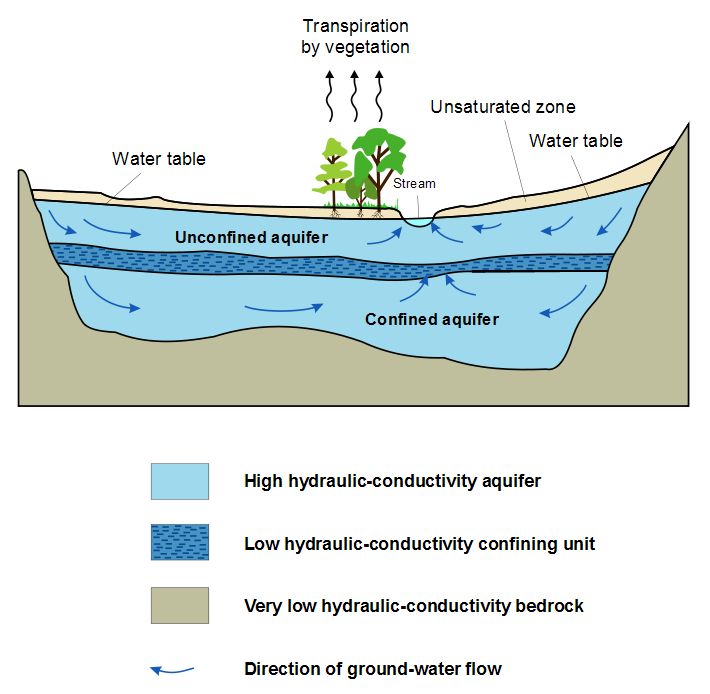
Figure 5.0 Ground Water Models
(Ecology, 2014)
- Surface water models. These are computer models used to understand surface water systems and potential changes due to natural or anthropogenic influences.
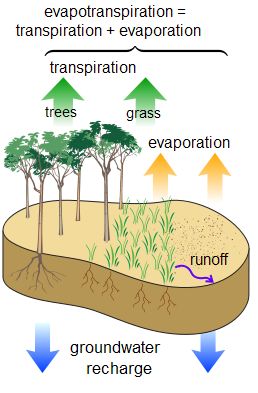
Figure 5.1 Surface Water Models
(Ecology, 2014)
5.2 Cartographic Modelling
A cartographic information model is the codification of the geographic elements, traits and procedures that deliver a coveted guide or items through determined programming. This incorporates particular of every geographic component and names that will show up on the maps, and their symbology. It incorporates stipends for the product to deal with or handle the information properly and effectively keeping in mind the end goal to make the maps. While information models can be explained in an assortment of courses, through books of determinations, UML outlines, hierarchical diagrams, and so on., cartographic information models are best communicated when the maps themselves are what composes the data in the information show (California Environment Health Tracking PRogram, 2010). It has returned to the familiar saying, “words usually can’t do a picture justice”.
Leverage of cartographic information displaying is that it obliges us to contemplate delineate and the guide making process. By and large we realize that it’s anything but difficult to wind up permitting the product to drive our guide’s outline instead of outfitting the energy of the product to successfully and effectively execute a pre-considered plan (Alam, 2012).
Cartographic information models that reflect both guide plan and programming abilities can and ought to impact the essential information catch and starting database assemblage and in addition consequent refresh by guaranteeing that the prerequisites for making all maps and information items are installed in the database outline. For instance, in the Figure 5.2, which demonstrates a segment of a topographic guide of Southern California with the names for physiographic highlights e.g., mountain ranges and valleys, which were a piece of the guide’s particular.
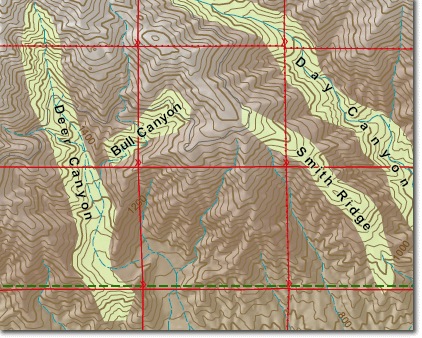
Figure 5.3 Topographic Segment
(Ecology, 2014)
These features are not normally captured in GIS databases, but we knew that maplex could automatically label the features as required if the features were stored as polygons. Knowing this mapping requirement and the software functionality at the outset allowed us to design the initial database so that these date were included.
5.3 Topographic Modeling
topographic demonstrating is the point at which a Three-dimensional model is worked to show components of the earth and underground. they are frequently used to indicate proposed outlines of redevelopment in situations where the general population is incredibly included, for example, open transportation. These models show all parts of a last item and give people in general something unmistakable to investigate. 3D models cannot just precisely delineate the physical elements of a plan, they can likewise indicate connections, for example, the relationship of structures to streets, and social viewpoints, for example, open transportation to group focuses. Generally 3D models demonstrate the geology of the territory, which means they indicate form lines which speak to relative positions and rises of the area. They can likewise indicate what is underneath the surface, for instance, water pipe lines.
3D demonstrating is particularly valuable while redeveloping a casual settlement, it permits the general population to get required in the arranging procedure which helps them settle on their choice to acknowledge changes before they happen. Since there are individuals as of now living, and working in the casual settlement, makes their assessment matters the most. Additionally, a 3D model is likewise useful as a model later on when follow-up changes should be made. Topographic displaying is a helpful device when chipping away at undertakings that require joint effort and imagination. Instead of 2D GIS mapping, topographic models can give an establishment to an incorporated arranging approach that truly unites various themes into a solitary physical thing. Topographic models comprise of a downsized adaptation of a territory of land and forms that show change in height (Ecology, 2014). The thickness of the forms, or the shape interim, differs in light of the requirements of the venture, however all in all thicker forms are more fitted for displaying huge changes in rise though more slender shapes give a smoother search and are useful for models with littler changes in height. The materials utilized as a part of making land models change however the general technique is comparative. These materials incorporate such things as layered cardboard, wood, putty or even plastic nourishment holders. As appeared in Figure 5.4, the model building process comprises of dissecting a topographic guide, then stacking the favored building material to give the model profundity. Topographic models are most effectively made straightforwardly from topographic maps that demonstrate the shapes of the land, despite the fact that this is not completely fundamental.
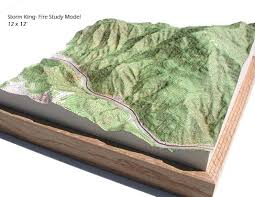
Figure 5.4 Model
(Ecology, 2014)
5.4 Geometric Networks
Geometric systems offer an approach to model normal systems and frameworks found in this present reality today. Water dissemination, electrical lines, gas pipelines, telephone utilities, and water stream in a stream are all cases of asset streams that can be displayed and dissected utilizing a geometric system. Once a geometric system is demonstrated, you can profit by performing different system investigations. Geometric systems are involved two sorts of components: edges and intersections. Edges and intersections in a geometric system are exceptional sorts of elements in the geodata-base called organize highlights. Consider them point and line highlights with additional conduct that is particular to a geometric system. Like different components in the geodata-base, they have conduct, for example, areas and default values. Since they are a piece of a geometric system, they have additional conduct, for example, a mindfulness that they are topologically associated with each other and how they are associated: edges must interface with different edges at intersections; in the system, the spill out of one edge to another is exchanged through intersections. A geometric system is an arrangement of associated edges and intersections, alongside availability runs, that are utilized to speak to and show the conduct of a typical system foundation in this present reality. Geodatabase highlight classes are utilized as the information sources to characterize the geometric system. You characterize the parts that different elements will play in the geometric system and standards for how assets course through the geometric system.
In the figure 5.5, a geometric system models the stream of water through water mains and water benefits that are associated by intersection fittings:
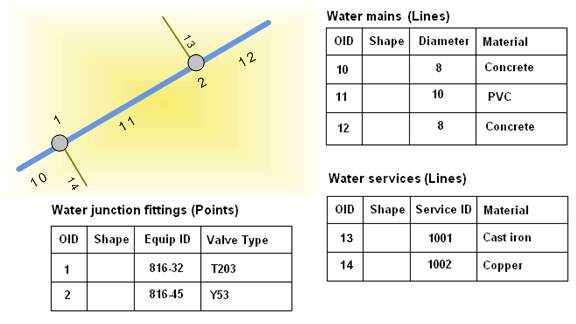
Figure 5.5 Geometric System Model
(Ecology, 2014)
A geometric system is worked inside an element dataset in the geodatabase. The component classes in the element dataset are utilized as the information hotspots for system intersections and edges. The system network depends on the geometric incident of the elements in the element classes utilized as information sources. Each geometric system has a coherent system—an accumulation of tables in the geodatabase that stores availability connections and other data about the elements in the geometric system as individual components for use in following and stream operations.
6.0 Ocean GIS Initiative
Geographic data framework (GIS) innovation, which has unquestionably given viable answers for the mix, perception, and investigation of data about land through ground or ethereal reviews, is currently being utilized to overview water bodies. Lately, our capacity to gauge change in the water bodies is expanding, not just as a result of enhanced measuring gadgets and logical procedures additionally on the grounds that new GIS innovation is helping us in better understanding this dynamic condition. The world’s 75% water and the vast majority of it isn’t overviewed, with the GIS know ocean bottom mapping hasn’t been less demanding. Hydrographic looking over is one of the most elevated developing field in which much work is required.
6.1 Areas of Focus
Organizations sea GIS activity is creating mapping and spatial examination devices, geospatial information, related assets, and engagement with the seas group in the fundamental regions:
- Research and Exploration
- Sea floor mapping and inspecting, geomorphological reviews, and tectonophysics
- Benthic living space mapping for assessing species wealth, recognizing fundamental environment, and at last saving touchy or jeopardized territories.
- Shoreline examination, including computation of rate-of-progress insights from different shoreline positions to break down authentic shoreline change.
- Climate change, including measuring or recreating the potential effects of ocean level ascent on shorelines and wetlands, effects of tempests because of expanding sea temperatures, effects to biological communities because of expanding sea fermentation, and worldwide vitality exchange. Perils, including the examination of hazard and potential loss of structures and foundation because of typhoon winds, beach front surges, tidal waves, and nearshore or inland tremors
- Ecosystems and Environment
- Coral reef wellbeing and structure, mangrove appraisal, estuary reclamation, association of beach front biological community administrations, and administration of seascape to streamline administrations.
- Coastal and pelagic creature following and marine well evolved creature genomics
- Marine flotsam and jetsam mapping and following, particularly in situ, as little plastics are not distinguishable with satellite symbolism.
Conclusion
This report has detailed the knowledge surrounding Geographic Information System (GIS) by discussing the following: advancements in new technology and techniques from conventional GIS, the risks and uncertainties associated with data gathering, processing and analyzing. The relevant background and history pertaining to the growth and establishment of GIS, further development in data capturing techniques, and the significance of composing calculated conclusions through data analysis.
Map making is being performed in day to day routines. From navigating to work or traveling across the country in search of different routes, maps are being used and made every day. Refining map data has been significantly upgraded by utilizing GIS innovations, this helps groups give way to assemble, investigate and use an expansive range of information. The data generated by GIS serves to help future land surveyors gain a better insight on how GIS is a useful instrument in gathering applicable information for projects and calculations.
In conclusion, GIS is a relevant topic related to surveying.
References
Bedker, S. (2009, October 08). Use the Five-Step GIS Analysis Process. Retrieved March 23, 2017, from https://blogs.esri.com/esri/esritrainingmatters/2009/10/08/use-the-five-step-gis-analysis-process/
Berry, J. K. (2007). Map analysis: understanding spatial patterns and relationships. San Francisco, CA: GeoTec Media. Retrieved March 12, 2017, from http://www.innovativegis.com/basis/Books/MapAnalysis/TofC_with_links.pdf
Bolstad, P. (2005). GIS fundamentals: A first text on geographic information systems. Eider Press, 620 pp. – See Chapter 14 on Data Standards and Data Quality
Borneman, E. (2014). Recent Advances in GIS Technology . GIS Lounge. Retrieved March 14, 2017, from https://www.gislounge.com/recent-advances-gis-technology
Cartography. (n.d.). (Photograph) Retrieved March 29, 2017, from http://geography.name/cartography/
Gliklich, R. E. (2014). Data Sources for Registries. Retrieved March 15, 2017, from https://www.ncbi.nlm.nih.gov/books/NBK208611/
GEOG 2700 Lecture 13 – Digitizing Vector Data and Digitizing Errors. (2015, May 19). Retrieved March 29, 2017, from https://www.youtube.com/watch?v=J95iZQ8y2d
Hartley, A. (2017). The Remarkable History of GIS. Retrieved March 14, 2017, from http://gisgeography.com/history-of-gis/
Morais, M. (2011, September 06). Spatial Data Mining. GIS Lounge. Retrieved March 23, 2017, from https://www.gislounge.com/spatial-data-mining/
Nar Marratum Babylonian World Map. (n.d.). Retrieved March 29, 2017, from http://www.bibleorigins.net/BabylonianWorldMapNarMarratum.html
Ondusi, M. (2010). History of development of GIS. Retrieved March 24, 2017, from http://www.academia.edu/9089657/History_of_development_of_GIS
Schmandt, M. (2014.). Ch. 2: Input. Retrieved March 20, 2017, from http://giscommons.org/chapter-2-input/
Surfer 8 – 3d contour maps and surface plots software. (n.d.). (Photograph) Retrieved March 29, 2017, from http://www.ssg-surfer.com/html/surfer_details.html
Alam, B. M. (2012). Applications of Geographic Information System. Los ngeles: InTech.
California Environment Health Tracking PRogram. (2010, 09 15). Tools & Services. Retrieved from Geocoding: http://cehtp.org/faq/tools/frequently_asked_questions_about_geocoding#top
Droopchan, D. (2017, 02 23). GIS. (S. Ahmed, Interviewer)
Ecology, O. (2014, 03 22). Ocean Ecology. Retrieved from Hydrology: http://www.oceanecology.ca/hydrology.htm#HydrologicalModels
frank. (17, 01 24). GIS Geography. Retrieved from LIDAR: http://gisgeography.com/lidar-light-detection-and-ranging/
Ken. (2009, 10 27). Topo Scanner. Retrieved from Blogspot: http://toposcanner.blogspot.ca/2009/10/components-of-mobile-lidar.html
Library, D. C. (2010, 08 22). GIS/ Science. Retrieved from Analysis & Modelling: http://researchguides.dartmouth.edu/gis/spatialanalysis
Cite This Work
To export a reference to this article please select a referencing stye below:
Related Services
View allRelated Content
All TagsContent relating to: "Information Systems"
Information Systems relates to systems that allow people and businesses to handle and use data in a multitude of ways. Information Systems can assist you in processing and filtering data, and can be used in many different environments.
Related Articles
DMCA / Removal Request
If you are the original writer of this dissertation and no longer wish to have your work published on the UKDiss.com website then please:




